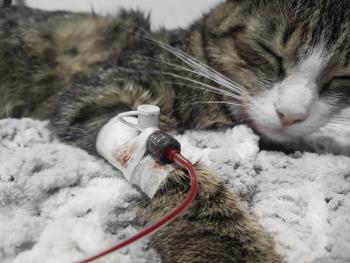
Toxicology case studies: medications affecting the nervous system (Proceedings)
Citalopram is a Selective Serotonin Reuptake Inhibitor (SSRI). The therapeutic dose in dogs is 1 mg/kg PO q 24 h. Per APCC Database: 1 mg/kg depression and 29 mg/kg tremors, seizures. Citalopram overdose results in serotonin syndrome. Serotonin syndrome is a complex group of clinical signs resulting from the over stimulation of serotonin receptors and can include the following:
Citalopram
Citalopram is a Selective Serotonin Reuptake Inhibitor (SSRI). The therapeutic dose in dogs is 1 mg/kg PO q 24 h. Per APCC Database: 1 mg/kg depression and 29 mg/kg tremors, seizures. Citalopram overdose results in serotonin syndrome. Serotonin syndrome is a complex group of clinical signs resulting from the over stimulation of serotonin receptors and can include the following: 1. CNS effects: dementia, disorientation, agitation and seizures, 2. Autonomic effects: salivation, vomiting, diarrhea, hyperthermia, hyper/hypotension, mydriasis and 3. Neuromuscular effects: rigidity, hyperreflexia, ataxia and tremors. In humans, it is most commonly associated with concurrent or consecutive use of two serotonergic drugs. Serotonin syndrome is a severe, often life-threatening condition which requires immediate and aggressive treatment with close monitoring.
In veterinary medicine serotonin syndrome has been reported with overdoses of serotonergic agents. The signs of serotonin syndrome in dogs include hyperthermia, diarrhea, depression or agitation, disorientation, vocalization, tremors, seizures, vomiting, ataxia and clinical blindness.
Treatment includes stabilizing the patient then deciding on decontamination. Emesis is indicated if the patient is asymptomatic and no other contraindications. Activated charcoal may also be used. Supportive care will include managing seizures, tremors or rigidity, hyperthermia and GI signs, providing CV support, monitoring acid/base, electrolytes, EKG and blood pressure. There is a significant risk for DIC, rhabdomyolysis, or multi-organ failure if prolonged seizures or hyperthermia. Cyproheptadine is a non-selective serotonin antagonist that aids with hyperthermia, vocalization and disorientation. The dose is 1.1 mg/kg PO or rectally (cats 2-4 mg/cat) and can be repeated q 6-8 hr prn. Acepromazine or chlorpromazine may also be effective since they are 5-HT2 receptor antagonists and propranolol is a 5-HT1A receptor antagonist. Nitroglycerin may help to alleviate serotonin syndrome through nitric oxide mediated downregulation of serotonin.
There is no diagnostic test for serotonin syndrome because the increase in serotonin is at synapse, not in serum. There is a large list of differential diagnoses including other toxins like metaldehyde, lead and antifreeze and encephalitic syndromes like rabies and canine distemper. Signs generally resolve over 12-24 hours with symptomatic treatment. The prognosis worsens if DIC or rhabdomyolysis develops.
Alprazolam
Alprazolam (Xanax) is a benzodiazepine. The mechanism of action is uncertain but it may antagonize serotonin or act as GABA agonist. Alprazolam has a fairly wide margin of safety unless mixed with other CNS depressants. The duration of action is short. CNS and respiratory depression are most common following exposure. Many patients will be ataxic, drooling and depressed. Some patients will instead be disoriented, agitated, vocalizing. Some patient may show paradoxical dysphoria (very young, very old, or very high doses).
Treatment includes emesis if the patient is asymptomatic and/or activated charcoal if it is safe to give. Flumazenil is used as a reversal agent for severe CNS depression. For agitation, a low dose of acepromazine can be used. Provide symptomatic and supportive care including thermoregulation and confine and keep away from obstacles for 24 hrs.
Baclofen
Baclofen is a centrally acting skeletal muscle relaxant which has a narrow margin of safety in dogs. Signs observed at doses < 1mg/kg and death has been observed at 4.4mg/kg and above. Common signs include hypersalivation, depression, vocalization, ataxia, respiratory depression and tremors. Other possible signs include bradycardia, seizure activity, recumbency and coma. The onset of clinical signs can be as early as 15 minutes post exposure, and as late as 7 hours post exposure. Clinical signs may last for several days in large overdoses.
Treatment includes emesis if the patient is asymptomatic and/or activated charcoal if it is safe to give. Symptomatic and supportive care includes IV fluid therapy at twice maintenance using a balanced electrolyte solution since fluid diuresis may enhance elimination. Pull a baseline chemistry panel with electrolytes and repeat as needed. Vocalization has been successfully managed with cyproheptadine.
Provided adequate ventilatory support is available, the prognosis is generally good but seizing animals have a guarded prognosis. No long term sequela are expected.
Newsletter
From exam room tips to practice management insights, get trusted veterinary news delivered straight to your inbox—subscribe to dvm360.




